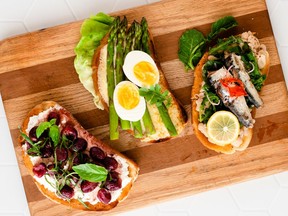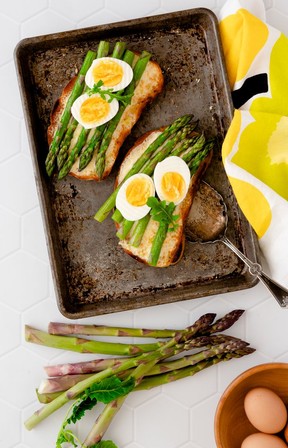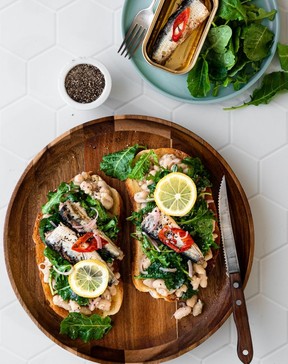Reviews and recommendations are unbiased and products are independently selected. Postmedia may earn an affiliate commission from purchases made through links on this page.
Karen Barnaby: Toast goes upscale with flavourful new kicks

Toast is probably one of the first things we were taught to cook as children — and we discovered that we could personalize it

Article content
One of my favourite childhood toasts was lightly burnt toast with peanut butter and grapes. I preferred a medium toast for my everyday toast needs but there was something special about the slight bitterness of the toast blended with the buttery, salty smoothness of the peanut butter and the sweet and sour burst of the grapes.
Advertisement 2
Article content
Another good toast memory is the milk toast served by my grandmother. Small squares of buttered toast, bathed in hot milk and sprinkled with brown sugar edged into heavenly, eating my way through the layers in the bowl as it transformed from crunchy to soft.
In the adult realm of toast, bruschetta reigned. My favourite Italian restaurant made what I consider to be the best, and basic version. Thick slices of chewy bread were deeply grilled, rubbed with a clove of garlic and fresh basil leaves then doused with just the right amount of olive oil. It was a far cry from what happened when bruschetta crossed the line into popular food culture; soulless bread under mushy underripe tomatoes.
The artisanal bakery movement stirred up not only how bread is made, and what carefully made bread looks and tastes like, but also how it is served. The pasty bruschetta gave way to tartines — the French version of an open-faced sandwich which can be served on toasted bread or not — that began popping up on menus. It then seemed to morph into “toast,” probably because it’s easier to relate to, as well as being a good use for day-old artisanal bread.
Advertisement 3
Article content
Is it odd that good memories start with toast? I don’t think so. Toast is probably one of the first things we were taught to cook as children, eagerly awaiting its pop from the toaster with butter knife in hand, we discovered that we could personalize it. Toast can just be toast and is very comfortable being on its own. But it also likes meeting new ingredients and will do its best to support them. There are lessons to be learned from toast.
Notes: For a visual on the size of the slices of bread, hold up your hands pretending that you’re eating a big burger that is about 4-inches (10 cm) tall. Widen the gap between your hands to 3 inches (7.5 cm) and you will have a close approximation to the size of the bread I used. It’s a good size for a dinner toast and can be served with a green salad, potato salad, coleslaw or cooked vegetables.
Advertisement 4
Article content
All of the recipes can be easily doubled to make 4 servings or halved to make one serving.
I made the toast under the broiler set to 450 F (230 C) with the rack 4 inches (20 cm) away from the heat.

Asparagus with Melty Cheddar and Egg
I’ve used hard cooked eggs to keep it simple but if you don’t mind a bit of co-ordinating, fried or poached eggs are luscious on this. You can sub small, cooked broccoli or cauliflower florets for the asparagus.
2 Tbsp (30 mL) mayonnaise
1 tsp (5 mL) Dijon mustard
2 oz (60 g) shredded aged cheddar cheese, about 1 cup (250 mL)
1 Tbsp (15 mL) thinly sliced green onion
10 large spears of asparagus, trimmed, blanched and cooled
2 large eggs, hard cooked to your liking, peeled
Advertisement 5
Article content
2 slices toast
Place an oven rack approximately 4-inches (10 cm) away broiler and turn the heat to medium high.
Mix the mayonnaise, mustard, cheese and green onion together until evenly combined. Place the toast on a baking sheet and spread evenly with the cheese mixture. Place under the broiler and broil until the cheese starts to turn golden in spots. Arrange the asparagus on top and return to the broiler to heat the asparagus, about a minute.
Cut the eggs in half or slice and arrange over the asparagus. Serve immediately.
Makes 2 servings

Greens, Beans and Sardines
Use your preferred olive oil-canned sardines. If sardines are not your favourite, you can use oil-packed tuna instead.
1 can oil-packed sardines, approximately 120 g (4 oz)
Advertisement 6
Article content
1 1/2 tsp (7.5 mL) lemon juice
1 Tbsp (15 mL) thinly sliced shallot or red onion
salt and pepper
2 tsp (10 mL) olive oil
2 cloves minced garlic
1 14 oz can cannellini beans or navy beans, drained and rinsed
2 slices buttered toast
2 cups (500 mL) loosely packed arugula or other small greens
lemon slices to garnish if desired
To make the dressing, drain the can of sardines, reserving the juices and letting the oil rise to the top. Combine 1 Tbsp (15 mL) of the sardine oil with the lemon juice and shallots. Season to taste.
Heat the olive oil in a small pan over medium heat. Add the garlic and fry until it turns pale gold. Add the beans, 2 Tbsp (30 mL) water and lower the heat. Stir to heat through, lightly mashing a few of the beans to form a thickish sauce. Season to taste — a lot of black pepper is great — and remove from the heat. Evenly top the toast with the beans. Toss the greens with the dressing and pile on top of the beans. Place the sardines on top and serve immediately.
Advertisement 7
Article content
Makes 2 servings

Ricotta, Roasted Grape and Basil
To add some crunch, sprinkle the finished toast with roasted and coarsely chopped nuts or pumpkin seeds.
1/2 lb (250 g) red seedless grapes, stemmed, about 1 1/2 cups (375 mL)
2 tsp (10 mL) olive oil
salt
1 tsp (5 mL) balsamic vinegar
1 tsp (5 mL) honey
1/2 cup (125 mL) ricotta cheese
1 Tbsp (15 mL) finely shredded basil leaves
2 slices buttered toast
Heat the oven to 350ºF (125ºC). Place the grapes in a small roasting dish and toss with the oil and a sprinkling of salt. Roast for 30 minutes, shaking the pan halfway through. The grapes will be wrinkly. Cool slightly then stir in the vinegar and honey.
Spread the toasts with the ricotta and garnish with the grapes. Sprinkle with the basil and serve immediately.
Makes 2 servings
Source: vancouversun.com


